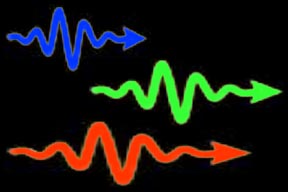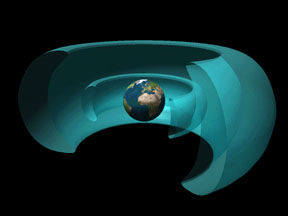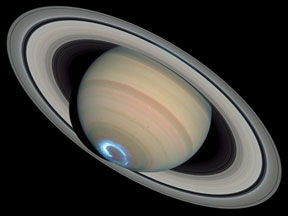Electron
An electron is one of the most important types of subatomic particles. Electrons combine with protons and (usually) neutrons to make atoms. Electrons are much smaller than neutrons and protons. The mass of a single neutron or proton is more than 1,800 times greater than the mass of an electron. An electron has a mass of 9.11 x 10-28 grams. Electrons have a negative electrical charge, with a magnitude which is sometimes called the elementary charge or fundamental charge. Thus an electron is said to have a charge of -1. Protons have a charge of the same strength but opposite polarity, +1. The fundamental charge has a strength of 1.602 x 10-19 coulomb. A neutral atom has equal numbers of electrons and protons. The electrons in an atom swarm in a cloud around the small, dense nucleus, which is made up of neutrons and protons. The negatively charged electrons are pulled towards the nucleus by the positively charged protons. Sometimes electrons can be knocked loose from an atom, taking along their negative charge and leaving behind an ion with a net positive charge. Electrons can dwell at various energy levels within an atom. When electrons move from one energy level to another, they either absorb or emit a photon. Electrons in different atoms have different energies associated with their energy level transitions. The different energies of photons emitted or absorbed by different elements serve as "fingerprints" that scientists can use to identify specific elements. These "fingerprints", in the form of spectra of light or photons of other wavelengths, allow us to determine, for example, that distant stars are made mostly of hydrogen. Electrons are a type of lepton, a class of subatomic particles which also includes muons and tauons. Electrons are often torn loose from their parent atoms. Such "free electron" can be accelerated, because of the electron's charge, to very high speeds and energies by electrical and magnetic fields. Such energetic free electrons are a form of particle radiation. Large numbers of electrons can flow when exposed to an electrical or magnetic field. A flow of electrons is called an electrical current. We are all familiar with the flow of electricity within wires in our houses. Electrical currents can flow outside of wires as well, such as in the ion- and electron-rich layer of Earth's atmosphere called the ionosphere. |
 Atomic Physics and Particle Physics
Atomic Physics and Particle Physics
 Fundamental Physics relevant to Space Weather
Fundamental Physics relevant to Space Weather
 A Matter of Scale - interactive showing the sizes of things, from very tiny to huge - from NSF
A Matter of Scale - interactive showing the sizes of things, from very tiny to huge - from NSF













